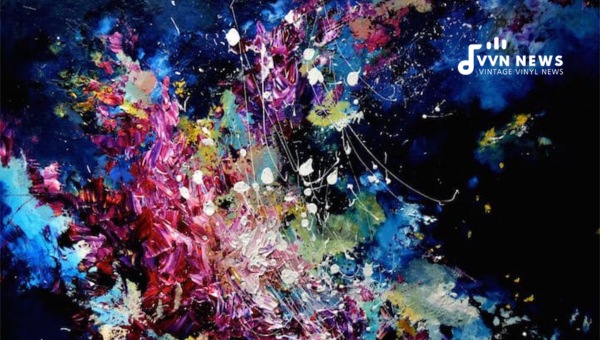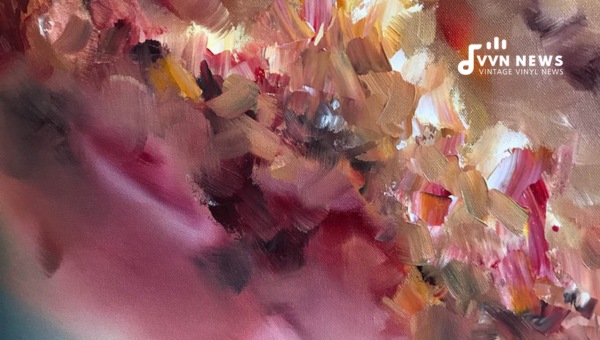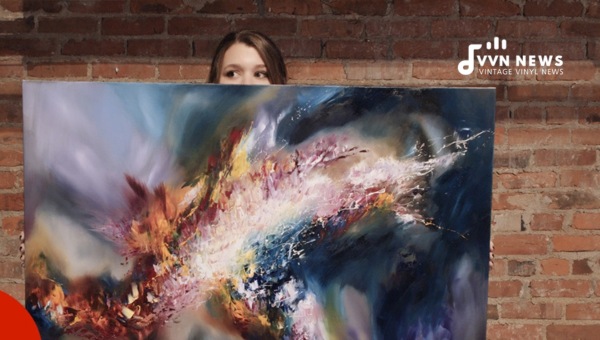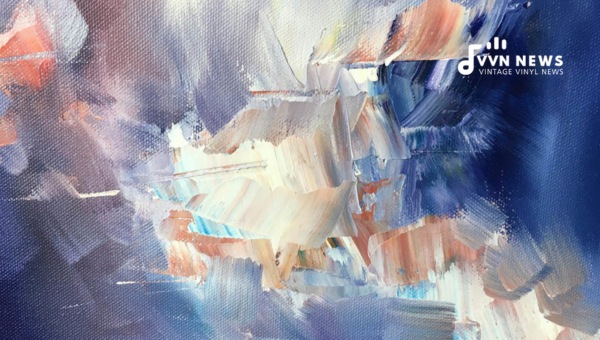In the dynamic realm of art, it’s often said that the best creators can paint what they see.
But, for a select few, this phrase holds an extraordinarily vivid significance.
Among these exceptional individuals is Melissa McCracken, a gifted artist with a rare neurological condition known as Musical Synesthesia – paintings by Melissa McCracken offer a beautifully rendered glimpse into her unique perceptual experiences.
Imagine hearing the lilting strains of a piano and seeing ribbons of blue threading through the air or listening to a soulful ballad accompanied by glowing swirls of deep violet haze.
This is the everyday reality for musical synesthetes like Melissa McCracken. In this article, we’ll delve into her mesmerizing world where sounds manifest as splashes of color and music become tangible beneath her fingertips.
Exploring the Fascinating World of Musical Synesthesia

Musical Synesthesia, often called auditory-visual synesthesia, is a unique neurological condition where an individual involuntarily sees sounds as distinctive colors.
For instance, a synesthete might associate the note C with red, or a violin’s melody could conjure an iridescent canvas inside their mind.
This puzzling yet intriguing occurrence happens due to certain crossings or connections in their brain that aren’t present in everyone.
What is Musical Synesthesia?
Musical Synesthesia occurs when two or more senses intertwine. Simply put, it allows you to perceive music not just as pleasing auditory rhythms but also as spontaneous visual experiences.
To capture the essence of this magnificently overlapping sensory phenomenon might sound baffling with conventional sensory perceptions; however, for synesthetes such as Melissa McCracken, it’s nothing less than painting with magical colors sourced directly from melodies and harmonies!
Offering Insights into the Phenomenon
Medically speaking, this vibrant occurrence happens due to the cross-wiring of brain circuits usually meant to process distinct sensory data.
In other words, these circuitry crossovers create simultaneous sensory experiences.
Interestingly, synesthesia is not a disease or disorder; it’s merely a different organization of neural pathways that embellish one’s perception of the world.
Here’s a fascinating aspect: Researchers estimate that nearly 1 in 2000 people could be synesthetic, indicating that while rare, they twirl among us very much.
Also Read: F Music Note [Unlock The Secrets Of The Musical Alphabet]
Melissa McCracken’s Paintings
Melissa McCracken paints music – not metaphorically but literally. As a synesthete, she sees each musical note and sound as radiant splashes of color dancing before her eyes.
Her richly textured and seamlessly flowing compositions are her attempts at capturing this extraordinary sensory marriage within her.
Melissa aims to map the vibrant colorscape in her mind’s eye onto her canvas, thus making sound visible to us all.
Her paintings are nothing short of a luminous grandeur emerging from an orchestra!
Melissa McCracken’s synesthetic art offers an exclusive peek into a transformative world where different sensory experiences intermingle and manifest as astonishingly vibrant creations on the canvas.
The Artistic Expression of Sound: Melissa McCracken’s Synesthetic Artworks
In the expansive panorama of artistry, one often comes across creations that strike a chord, resonating deep within.
Such is the magic that Melissa McCracken’s synesthetic artworks weave. As they say, art is subjective, reflecting the poet’s lyrical sentiments, the dancer’s rhythmic expressions, and, in this unique instance – a synesthete artist’s vibrant visualization of sound!
Discovering the Invisible Connection between Music and Color
It may seem unusual for those who experience music in its traditional auditory form to comprehend a rich color palette emanating from mellifluous tunes.
For Melissa McCracken – each note resonates with specific shades.
An ethereal veil of cerulean accompanies the rustling of leaves while Stevie Wonder’s voice manifests as splashes of gold mixed with bursts of orange and crimson.
This seamless interplay between audio and visual perception gives her a unique framework that inspires her breathtaking creations.
The Unique Perspective of a Synesthetic Artist
Hers is not just another interpretative dance between brush and canvas.
McCracken’s artwork captures unseen melodies woven into bold strokes smeared across a vibrant colorscape, heralding an exclusive standpoint. It’s not merely her interpretation; it’s her unique perception itself!
Each visual representation is guided by her personal sensory experience – an iridescent tapestry created by rhythm, melody, complexity, and timbre.
Where we hear music, she sees dynamic forms swirling in multi-hued grandeur—a symphony on canvas.
Also Read: Phrygian Mode [Adding Exotic Flair To Your Musical Compositions]
Unveiling the Process Behind Melissa McCracken’s Paintings
It begins with a musical piece that moves her deeply; from there, she lets its hues guide her brush strokes.
To kick start this delicate process, she listens to the piece multiple times, allowing its distinct color pattern to emerge, form, and re-form in her mind’s eye.
Once the painting begins, she continuously toggles the playback, letting the ebb and flow of music dictate the layers of colors and their intensity on her canvas.
McCracken believes it is essential to directly translate what she sees when she hears different sounds, thus turning an ephemeral melody into a tangible visual object.
This remarkable artistry paints emotions in their true colors—a sonorous ballad evokes serene turquoise swipes while a jubilant symphony springs forth a riot of vibrant hues.
As we delve deeper into this enchanting world where music plays out in vibrant visuals, one can’t help but marvel at the harmonious coexistence of sound and color.
Melissa McCracken’s paintings offer a palette of possibilities, stirring a symphony of awe-inspiring colors.
Undoubtedly, stepping into her canvas-filled world is like walking across a magical land where melodies don’t just create ripples in water but paint a universe on an easel!
Immersed in a Symphony of Colors: Melissa McCracken’s Artistic Vision

Melissa McCracken’s synesthetic art is an arresting fusion of senses and color.
The immersive aesthetic experience compels the viewer to delve into a realm where music is not just a musical tone heard through the ears but an astonishing array of shades and hues that one can visually savor.
Also Read: Aeolian Mode [The Secret To Creating Moody & Expressive Music]
Translating Melodies into Brushstrokes: Melissa McCracken’s Technique
As a synesthete, Melissa translates her auditory perceptions into visual impressions with complete artistic liberty, capturing their essence on canvas. But how does she transform this exceptional phenomenon inside her brain into breathtaking masterpieces?
Firstly, she connects deeply with the music. This involves immersing herself in every chord and rhythm until she catches hold of its color impression.
She ardently sketches the shifting tones on paper to form what she refers to as ‘color maps.’ These initial ‘color maps’ lay the foundational structure for her paintings.
Secondly, McCracken interweaves her emotions with those rhythmically charged hues.
This interplay results in variegated layers of paints on canvas that reflect the harmonies and their emotional resonance.
Finally, Melissa’s choice of materials echoes her sensory experiences. The artist uses oils, acrylics, and pastels to generate different textures, replicating the richness & depth she perceives in each melody.
Capture the Emotion: Conveying Music through Visual Mediums
A key aspect of Melissa’s art is translating emotions attached to distinct musical elements into discernible visual cues.
Each composition is an emotional landscape, painted intricately using colors inspired by musical notes.
Whether it’s conveying the soul-stirring melancholy embedded in “A Case of You” by Joni Mitchell or capturing ecstatic energy from “Imagine” by John Lennon, Melissa’s paintings pulsate with the song’s emotional heart.
Her synesthetic paintings testify to the profound dynamic link between music and color.
Engaging with Melissa McCracken’s Vibrant and Harmonious Canvas
Interacting with Melissa’s artwork requires patience as melodies unfold over time for the subtleties to emerge.
Her vibrant designs draw you into a flux of shades and textures, each brushstroke leading you through various moods sculpted by individual instrumentations.
Whether beholding her painting called “Gravity”, based on John Mayer’s hit track, or gazing into “Life on Mars,” inspired by David Bowie’s song, each interaction is like embarking on a mesmerizing voyage through space, time, and emotion.
Melissa McCracken’s art fosters an echoing melody that invites us into her sensory world filled with an intoxicating array of colors flowing out from the rhythm of music.
Exploring the Emotional Impact of Music-Triggered Synesthesia Artworks
There is a well-understood, almost universal accord of an intensely potent connection between music and our emotions.
Most people ‘feel’ music. But for synesthetic artists like Melissa McCracken, these feelings are not just metaphoric but paint a vivid visual spectacle.
Also Read: 20 Best Phaser Pedals [Top Picks For Epic Sound Effects]
The Powerful Connection Between Sound and Emotion
Music’s portrayal through color and textures in a painting invokes deep emotions even for non-synesthetes. Our brains naturally associate moods with specific colors, and through her expressions, Melissa creates an auditory-visual feedback loop that inspires emotional responses.
Happy songs draw out bright, exuding bold energy; melancholic rhythms reveal darker hues of blues or grays; celebratory tunes burst with vibrant spectra – such is the power of McCracken’s artwork that it creates tangible connections between sound and sensation.
Evoking Sensation through Color and Composition
Creating a synesthetic painting requires a thorough understanding of music’s designs from an individual perspective to the artist’s interpretation.
For instance, to represent the complex structure of jazz improvisation, Melissa might use vibrant swirls of colors splattered across her canvas in disordered synchrony.
A sudden cymbal crash might appear as brilliant sparks erupting within a dark realm.
A soft lullaby is perhaps painted as gently curving lines in soothing pastels, embodying the smooth contours of the melody.
It’s incredible how McCracken utilizes the amorphous properties of paint to depict fluid waves or pulses of sound through meticulous composition.
The Healing Potential of Experiencing Synesthetic Art
One distinctive aspect is the healing potential offered by experiencing these artworks.
Viewing synesthetic artwork provides emotional relief because they are more than just ‘aesthetic’ representations – they encapsulate feelings.
These visual translations can bridge communication barriers by taking you through the artist’s emotion-driven sensory experience.
Moreover, research indicates that engaging with art has multiple therapeutic effects, such as reducing stress and promoting mental wellness.
By igniting feelings of joy, wonder, and sometimes even catharsis, synesthetic art may play a central role in therapeutic disciplines in the future.
Melissa McCracken’s artwork is a testament to how deeply intertwined our senses can be, providing glimpses into experiences we may otherwise overlook.
It shows us that music-triggered synesthesia isn’t just about seeing sounds – it’s about unveiling emotions woven within melodies and harmonies in a truly transformative way.
Inspiring Creativity through Multiple Senses with Musical Synesthesia

Art, in its infinite expressions, can inspire minds and awaken creativity. With the magic of musical synesthesia, this power amplifies multi-fold as it invites individuals to perceive and interact with the world around them through cross-sensory experiences.
Melissa McCracken’s fascinating synesthetic artworks allow an insight into this captivating realm — where traditional boundaries melt away, making room for pioneering streams of artistic expression.
Also Read: 20 Best Volume Pedals [Top Picks For Controlling Your Sound]
Expanding Perception: A Glimpse into Cross-Sensory Experiences
Broadening our sensory perceptions can lead to a novel understanding of our environment.
Delving into musical synesthesia, you realize that sounds are not merely auditory pieces meant for your ears.
These sounds morph into visual spectacles that play rhythm before your wide-open eyes!
It introduces you to a vibrant kaleidoscope where colors entwine themselves around notes, creating a compelling and transformative immersive spectacle.
The hallucinatory quality ties in naturally with creative expression. Melissa’s art allows us to dip our toes into this cross-sensory realm and encourages us to explore unique perspectives hidden below our habitual perceptual capabilities.
Encouraging Alternative Forms of Expression through Multisensory Art
Through her art, Melissa offers an entirely novel form of artistic communication that transcends traditional mediums.
Her work beautifully articulates that sound is not just heard; it’s felt and seen. Melissa McCracken demonstrates that conventional parameters don’t confine art; instead, they can unfold into expansive multisensory experiences.
By pairing sound with color, she adds layers of emotionality and visceral strength to her artwork.
This provides viewers a new guide for interpretation – one rooted in cross-sensory perception that bridges gaps between music and visual art, amplifying the potent emotive content.
Awakening Imagination: Reflections on Melissa McCracken’s Revolutionary Work
Through her revolutionary work, Melissa has been at the forefront of cognitive and artistic exploration that pushes conventional sensorial boundaries.
She has harnessed her unique neurological gift to create breathtakingly vivid symphonies on canvas.
Her sweeping arcs of vibrant colors that fizz, splatter, and whirl around the canvas are not just richly textured forms; they effectively map her synesthetic experience, thereby unlocking viewers’ dormant imagination.
Each stroke brimming with color in McCracken’s paintings speaks volumes about her transformative sensory journey and inspires those who perceive art through traditional lenses.
By pushing perceptual barriers, Melissa engages to stir the creative soul within each of us.
Her work beckons us to lean into our senses – auditory or otherwise – to glean inspiration from unexpected realms and to explore uncharted territories in our artistic voyage.
Also Read: 20 Best Boost Pedals In 2025 [Pump Up Your Guitar Performance]
FAQs About Musical Synesthesia
What is synesthesia?
Synesthesia is a neurological phenomenon where stimulation of one sensory pathway leads to automatic, involuntary experiences in a secondary sensory path. It essentially bridges two or more senses.
How does musical synesthesia manifest?
For individuals with musical synesthesia, sounds, music, or voices trigger the visual perception of colors and patterns. Each note or sound has a specific associated color.
Are all synesthetes artists like Melissa McCracken?
No, not all synesthetes are artists. While many find creative outlets to express their unique experiences, it varies from individual to individual based on their personal interests and skills.
How has synesthesia influenced Melissa McCracken’s artwork?
Synesthesia plays a fundamental role in McCracken’s creative process by providing her with vibrant visual representations of music, which she then recreates through painting.
Can non-synesthetes experience what someone with musical synesthesia experiences?
Non-synesthetes cannot naturally experience what someone with musical synesthesia goes through; however, McCracken’s artwork provides a tangible visual representation of these extraordinary experiences.
Conclusion
Melissa McCracken is a testament to humans’ profound and mystical connection with art and music.
As a synesthete, her canvases reverberate with the resonating symphonies of colors derived from melodies, offering us a rare sensory gift.
Her works remain faithful in celebrating the beauty of music and illustrating how seamlessly diverse sensory experiences can weave an intricate yet altogether novel narrative.
Through her enchanting creations, we’re invited to celebrate this extraordinary union of sound, vision, and emotion in its most vivid manifestation.








